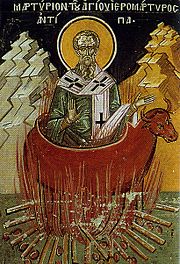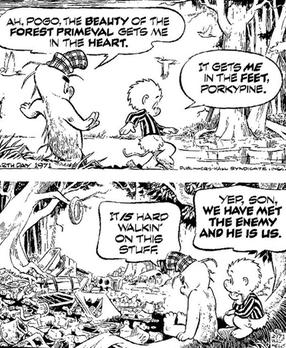 Designed in Greece by Perillos (not a Christian) of Athens, the condemned person was shut in the bull. There was a fire lit underneath the device. When the person was screaming it would sound like the bull was raging.
Designed in Greece by Perillos (not a Christian) of Athens, the condemned person was shut in the bull. There was a fire lit underneath the device. When the person was screaming it would sound like the bull was raging.
 Antipas roasted alive in a copper steer, AD 95.
Antipas roasted alive in a copper steer, AD 95.



The Rack.
One end had a fixed bar, where the feet were locked onto it, and the other end had a movable bar, where the hands were tied to it. It had a lever that was used as the interrogation progressed. It was on a lever and pulley system that would eventually cause the joints of the person being tortured to dislocate and then separate. Eventually, the muscle fibers, ligaments, and cartilage would break separating the limbs from the body. A relief of the torture of Saint John Sarkander on torturing rack at Sarkander's gravestone in 1620.
Bitowski of Bistritz falsely accused Sarkander of conspiring with King Sigismund. The rack was used on 13, 17 and 18 February. On each of the latter days the torture lasted for two and three hours, lighted candles and feathers soaked in oil, pitch, and sulphur were strewn over his body and ignited. He lingered from the effects for a month and died in prison.
A relief of the torture of Saint John Sarkander on torturing rack at Sarkander's gravestone in 1620.
Bitowski of Bistritz falsely accused Sarkander of conspiring with King Sigismund. The rack was used on 13, 17 and 18 February. On each of the latter days the torture lasted for two and three hours, lighted candles and feathers soaked in oil, pitch, and sulphur were strewn over his body and ignited. He lingered from the effects for a month and died in prison.
A similar device was the intestinal crank. This method of torture involved making an incision in the abdominal area, separating the duodenum from the pylorus, and attaching of the upper part of the intestine to a crank. The crank would then be rotated to extract the intestines from the gastrointestinal cavity of a conscious person.

Judas Cradle
This torture device is a pyramid shaped seat. The victim is placed on top of it, with the point inserted into an orifice, then they are very slowly lowered onto it. The condemned was usually naked in order to add to their humiliation. This device was thought to stretch the orifice or to slowly impale the person. The stretching of the orifice would cause pain, rips and tears, which would eventually cause death.

Galileo facing the Roman Inquisition.
Galileo Galilei, 15 February 1564– 8 January 1642) was an Italian physicist, mathematician, astronomer, and philosopher who played a major role in the Scientific Revolution. Galileo has been called the "father of modern observational astronomy,"[6] the "father of modern physics,"[7] the "father of science,"[7] and "the Father of Modern Science."[8] Stephen Hawking says, "Galileo, perhaps more than any other single person, was responsible for the birth of modern science.
The Catholic Church warned Galileo. He was tried by the Inquisition, found "vehemently suspect of heresy," forced to recant, and spent the rest of his life under house arrest.
The term Inquisition can apply to any one of several institutions charged with trying and convicting heretics (or other offenders against canon law) within the justice-system of the Catholic Church.
Amen.


Joan of Arc is interrogated by The Cardinal of Winchester in her prison 1431.
The Trial of Joan of Arc, which took place before an English-backed church court in Rouen, France in the first half of the year 1431 was, by consensus, one of the most significant and moving trials ever conducted in human history. It culminated in the burning at the stake of the person known to history as Joan of Arc, the young French peasant girl who was the defendant in the case. Later, the trial verdict would be reversed, completely exonerating her. She is now a French national heroine and Saint of the Roman Catholic Church.
How ironic that she be sainted by the very organisation that burned her alive. She prayed forgiveness to the end for her torturers.


Tomb of Cardinal Beaufort, Cardinal Bishop of Winchester
Henry Beaufort (c. 1375 – 11 April 1447) was a medieval English clergyman and Bishop of Winchester an anomaly in being both a bishop and a member of the royal house of Plantagenet.
The second son of John of Gaunt and his mistress Katherine Swynford, Beaufort was born in Anjou, an English domain in France, in about 1374 and educated for a career in the Church. After his parents were married in early 1396, Henry, his two brothers and one sister were declared legitimate by the pope and legitimated by Act of Parliament on 9 February 1397, but they were barred from the succession to the throne. On 27 February 1398 he was nominated Bishop of Lincoln and on 14 July 1398 he was consecrated. When his half-brother deposed Richard and took the throne as Henry IV of England, he made Bishop Beaufort Lord Chancellor of England in 1403. Beaufort resigned that position in 1404 when he was appointed Bishop of Winchester on 19 November.
Poor Henry...

Heretic's Fork
Abiuro - "I recant" - the latin phrase engraved into the side of this double-ended two-pronged fork, was the only phrase that the prisoner was allowed to speak. The head was tilted back sharply, with the top two prongs embedded deeply under the flesh of the chin; the bottom two prongs likewise embedded into the flesh above the sternum. The leather strap was fastened tightly behind the neck. Used during the Inquisition to hasten the confession of heresies real or imagined, those that refused to repent were summarily executed at the stake or by hanging - but were allowed Christian rites, no doubt a consoling factor. In the 17th century, during the Spanish Inquisition, burning at the stake was a popular choice for punishment since it did not spill the victim's blood (the Roman Catholic Church forbade this). The burning meant the victim would have no body to take into the afterlife.
In the 17th century, during the Spanish Inquisition, burning at the stake was a popular choice for punishment since it did not spill the victim's blood (the Roman Catholic Church forbade this). The burning meant the victim would have no body to take into the afterlife.
 Burning of Anneken Hendriks, Amsterdam, 1571
Burning of Anneken Hendriks, Amsterdam, 1571

Axe grinding jig for the do-it-yourselfer.
Note: It is not the belief of this poster that individual Christians or religious groups are potentially any different than other Homo sapiens or associations. Many humans are loving and just, yet simultaniously are violent, hate-filled, horrifying, loathsome devils.
For example:
| |||||||
"Vide", inquiunt, "ut invicem se diligant" - ipsi enim invicem oderunt - "et ut pro alteruto mori sint parati"; ipsi enim ad occidendum alterutrum paratiores erunt.
"Look," they say, "how they love one another" (for they themselves hate one another); "and how they are ready to die for each other" (for they themselves are readier to kill each other).
Usually quoted as 'See how [these Christians] love one another.'
Text is CSEL 69; translation is Glover, Loeb edition.








Such glorious deeds of ROYALS and THE CHURCH, carried out always in the name of "god".
ReplyDeleteHallelujah (praise ye Yahweh)
Matthew 7:15-20
ReplyDeleteBeware of false prophets, which come to you in sheep's clothing, but inwardly they are ravening wolves.
Ye shall know them by their fruits. Do men gather grapes of thorns, or figs of thistles?
Even so every good tree bringeth forth good fruit; but a corrupt tree bringeth forth evil fruit.
A good tree cannot bring forth evil fruit, neither can a corrupt tree bring forth good fruit.
Every tree that bringeth not forth good fruit is hewn down, and cast into the fire.
Wherefore by their fruits ye shall know them.
There appears to be a native human dichotomy between actions and between thoughts, perhaps arising from stubborn, total agreement with the latest insane argument presented.
ReplyDelete